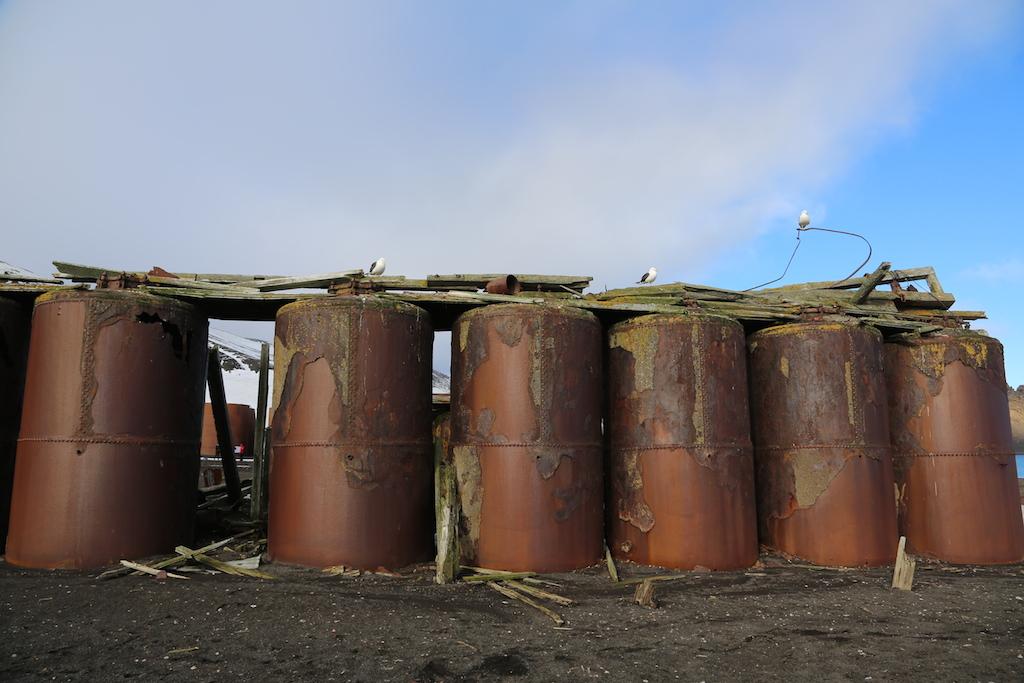Antarctica’s past offers a cautionary tale for future energy production
DECEPTION ISLAND, Antarctica — Between the abandoned buildings and the now-empty whale oil tanks, the wind howls. The paint has long ago peeled off the walls in the modest houses. Ornery fur seals grumble on the beach. This is a forsaken, haunted place.
“I love Deception Island and I hate Deception Island,” says Robert Swan, the polar explorer and leader of the Antarctic expedition I’m on. “What’s quite extraordinary is that we, the human race, were exploiting Antarctica. Talking about 2041, one tends to think: has it ever been exploited? Well, it has.” He points emphatically at the cold ground we’re standing on.
Swan is on a mission to save Antarctica beyond 2041, the year when the international treaty banning resource exploitation at the bottom of the earth is up for re-negotiation. After 2041, it is conceivable that fossil fuel and mineral drilling could commence in Antarctica, thereby contributing to global carbon emissions and potentially speeding up the very climate change that is already causing unprecedented melting of Antarctic ice. Swan gives such weight to this deadline 26 years in the future that he has chosen it as the namesake for his organization.
Much of what the organization 2041 does is an attempt to inspire action that will make sure Antarctica is never exploited and that it will remain an international preserve “for peace and science.” Swan brings me and 79 others from this year’s 2041 Antarctic expedition to Deception Island to present a cautionary tale, and remind us that man has already tried his hand at reaping Antarctica’s natural treasures for the purposes of energy production. But the unforgiving territory around us has never submitted quietly.
Deception Island, part of the South Shetland Islands just above the Antarctic Peninsula, forms a ring of mountains around a large bay. In the morning, we sail the entrance, a narrow channel called Neptune’s Bellows flanked by steep, jutting peaks. The island’s sandy shores once provided rare safe harbor for Southern Ocean sailors, sealers and whalers as far back as the early 19th century.
But Deception’s calm waters don’t reveal the full story. The island is the caldera of an active volcano, which has erupted on more than one occasion in modern times, destroying the flimsy attempts people have made at controlling anything in this exquisite yet brutal piece of Antarctic terrain.
The protected waters of the bay hold another grim secret. Here, for almost four decades, one of the largest whaling operations in history thrived. The bay was bloody and lethal – most often for the gentle beasts that rule the southern seas, but sometimes for humans, too. As Federico Gargiulo, an Argentine field guide and local historian on the trip tells me, “people drowned in the process of killing whales.” Once a whale had been caught and pulled up next to the boat, hunters would climb on top with spiked shoes and knives to carve their prey, struggling to keep balance. Whaling was a dangerous business.
Nonetheless, mariners had their sights on this island beginning in 1819, when a brisk but short-lived trade in fur seals brought boats to Deception’s shores. In 1906, a Norwegian-Chilean company started whaling the waters around the South Shetlands. The whalers built a permanent settlement in 1912, as well as a radio station and a hand-operated railway. More people moved in as the whaling industry boomed. At its peak, around 1920, there were around a couple hundred people living on what is now called Whalers Bay.
Amongst the remnants of this settlement, Swan and I talk about what occurred here. He tells me how the whales were harvested for their blubber, which was removed and boiled down in a rendering plant. In the pre-electricity era, whale oil was the western world’s primary lamp fuel. On Deception, oil was stored in huge tanks that dot the settlement, and eventually shipped off to light homes in London and Oslo and Santiago. The tanks look like gigantic steel oil drums. Swan and I peek in. They still reek of whale oil to this day; a musty, metallic, almost rancid smell. The only other parts of the whale used were the bones, which provided structure for women’s corsets.
By the 1930s, electricity was becoming the norm in western homes, and the practice of whaling began to slow across the globe. In 1931, with the whales driven to the edge of extinction and the price of whale oil plummeting, the industry was abandoned. The whalers packed up shop.
Next, a British expedition set up a science and research base in 1944. They were the last people to live on the island year-round. In the late 60s, as if to warn anyone who might get any ideas about colonizing Deception ever again, the volcano erupted several times. The buildings that had accrued over the years were almost all demolished. The remaining British scientists were forced to abandon their station.
I wander among the ruins with Charlie Drew, a tall, rangy English pilot along on the expedition. We stop near the hulking shell of an airplane hangar out near the edge of the settlement. It looms forlorn above the snowy ground. Charlie muses on what sorts of planes could’ve landed out here. “Let’s stay a few more minutes,” he says, poking around.
But the sun is setting, and it’s getting cold. Soon we will start making our way back to the beach, where Zodiac boats will ferry us from the island. Humans were never meant to stay too long in this place.
This story is presented by The GroundTruth Project.
We want to hear your feedback so we can keep improving our website, theworld.org. Please fill out this quick survey and let us know your thoughts (your answers will be anonymous). Thanks for your time!
